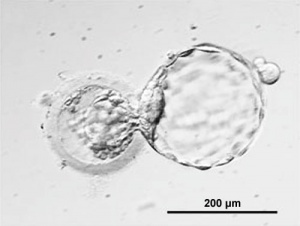Organoids
| Embryology - 25 Apr 2024 |
|---|
| Google Translate - select your language from the list shown below (this will open a new external page) |
|
العربية | català | 中文 | 中國傳統的 | français | Deutsche | עִברִית | हिंदी | bahasa Indonesia | italiano | 日本語 | 한국어 | မြန်မာ | Pilipino | Polskie | português | ਪੰਜਾਬੀ ਦੇ | Română | русский | Español | Swahili | Svensk | ไทย | Türkçe | اردو | ייִדיש | Tiếng Việt These external translations are automated and may not be accurate. (More? About Translations) |
Introduction
Organoids stem cell derived self-organized three-dimensional in vitro tissue cultures. These cultures have been be manipulated to replicate some of the complexity of an in vivo organ, or to produce only certain types of organ related cells.
Some Recent Findings
|
| More recent papers |
|---|
|
This table allows an automated computer search of the external PubMed database using the listed "Search term" text link.
More? References | Discussion Page | Journal Searches | 2019 References | 2020 References Search term: Organoids | Culture Organoid Culture |
| Older papers |
|---|
References
Journals
Reviews
Trounson A & DeWitt ND. (2016). Pluripotent stem cells progressing to the clinic. Nat. Rev. Mol. Cell Biol. , 17, 194-200. PMID: 26908143 DOI.
Articles
Pekkanen-Mattila M, Pelto-Huikko M, Kujala V, Suuronen R, Skottman H, Aalto-Setälä K & Kerkelä E. (2010). Spatial and temporal expression pattern of germ layer markers during human embryonic stem cell differentiation in embryoid bodies. Histochem. Cell Biol. , 133, 595-606. PMID: 20369364 DOI.
Search PubMed
May 2006 "stem cell" 154,176 reference articles of which 16,449 were reviews.
Search PubMed Now: stem cell | embryonic stem cell | adult stem cell |
External Links
External Links Notice - The dynamic nature of the internet may mean that some of these listed links may no longer function. If the link no longer works search the web with the link text or name. Links to any external commercial sites are provided for information purposes only and should never be considered an endorsement. UNSW Embryology is provided as an educational resource with no clinical information or commercial affiliation.
- NIH (USA) Human Embryonic Stem Cell Registry | [feed://hescregapp.od.nih.gov/hesc.xml RSS]
- StemBook - Table of Contents
- International Society for Stem Cell Research (ISSCR) is an independent, nonprofit organization formed in 2002 to foster the exchange of information on stem cell research.
- University of Michigan Stem Cells Explained
- Transcript of discussion on ABC Radio (Dr. J Kahn , Dr. JWagner) on Genetic Technology And Ethics
- A brief article on Cord Blood stem cells and their therapeutic potential from the BBC.
- Monash University (Australia) Monash Immunology and Stem Cell Laboratories (MISCL)
- Europe - ESTOOLS DATA@HAND "resource contains human gene expression array data from 97 GEO and ArrayExpress sample sets, which involve altogether 1674 Affymetrix, Illumina and Agilent arrays. The source of the biological samples is mainly pluripotent stem cells, their differentiated progeny, and their parent cells. All data has been preprocessed so as to enable computational analysis with analysis workflows and tools provided."
Glossary Links
- Glossary: A | B | C | D | E | F | G | H | I | J | K | L | M | N | O | P | Q | R | S | T | U | V | W | X | Y | Z | Numbers | Symbols | Term Link
Cite this page: Hill, M.A. (2024, April 25) Embryology Organoids. Retrieved from https://embryology.med.unsw.edu.au/embryology/index.php/Organoids
- © Dr Mark Hill 2024, UNSW Embryology ISBN: 978 0 7334 2609 4 - UNSW CRICOS Provider Code No. 00098G

